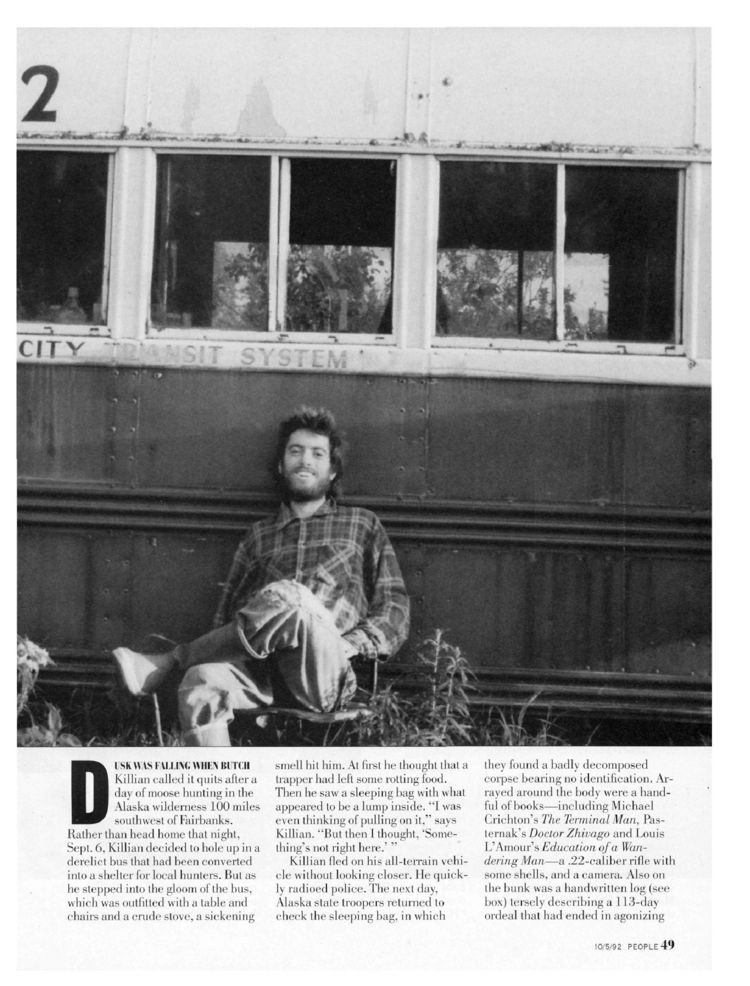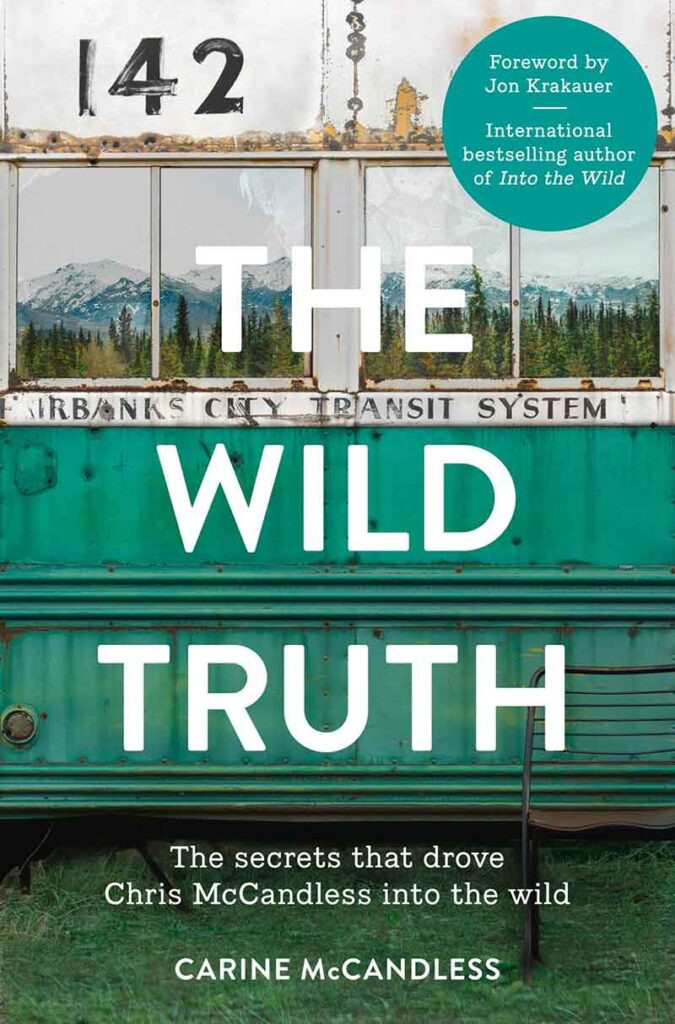Christopher John Mccandless, widely known for his journey “Into the Wild,” remains a captivating figure whose story continues to inspire and provoke reflection, and at johnchen.net, we delve into the complexities of his motivations and experiences. Understanding McCandless through the lens of leadership, personal freedom, and the allure of nature can offer valuable insights into human ambition and the search for meaning. This exploration also highlights the importance of informed decision-making and risk assessment.
1. Who Was Christopher John Mccandless?
Christopher John McCandless was a young American man who, after graduating from Emory University in 1990, chose to donate his savings, abandon his possessions, and embark on a nomadic journey across North America, ultimately seeking refuge in the Alaskan wilderness. His story, immortalized by Jon Krakauer’s book “Into the Wild” and the subsequent film adaptation, has made him a symbol of idealism, adventure, and the pursuit of self-discovery.
McCandless, also known as Alexander Supertramp, sought to disconnect from what he viewed as the constraints of modern society. He was driven by a desire to experience life in its rawest form, testing his limits against the backdrop of nature’s unforgiving beauty. His rejection of material wealth and societal norms resonated with many, making him a controversial but enduring figure.
 Christopher McCandless, the subject of "Into The Wild," in a reflective pose.
Christopher McCandless, the subject of "Into The Wild," in a reflective pose.
2. What Were The Key Events In Christopher John Mccandless’s Life?
The key events in Christopher John McCandless’s life trace a path of intellectual and spiritual seeking, punctuated by decisive actions that led him away from conventional society.
Early Life and Education
Born into an affluent family, McCandless excelled academically and athletically. However, beneath the surface of a privileged upbringing, he harbored deep-seated philosophical questions and a growing disillusionment with consumerism and societal expectations.
Graduation and Donation
After graduating from Emory University with honors, McCandless donated his $24,000 savings to charity and severed ties with his family, embarking on his journey without informing them of his plans. This act symbolized his rejection of materialism and his commitment to living according to his principles.
Nomadic Travels
McCandless adopted the alias “Alexander Supertramp” and hitchhiked and traveled across the American West, working odd jobs and encountering a variety of individuals who influenced his journey. He sought out experiences that tested his self-reliance and deepened his connection to nature.
Alaskan Wilderness
In April 1992, McCandless ventured into the Alaskan wilderness with minimal supplies, intending to live off the land. He hiked into Denali National Park and established a temporary camp in an abandoned bus, chronicling his experiences in a journal.
Tragic End
After several months in the wilderness, McCandless’s health deteriorated, and he ultimately succumbed to starvation. His body was discovered in the bus in September 1992, bringing a tragic end to his quest for self-discovery.
3. What Was Christopher John Mccandless’s Motivation For Going Into The Wild?
Christopher John McCandless’s motivation for venturing “Into the Wild” was a complex interplay of philosophical ideals, personal experiences, and a deep-seated desire for self-discovery. He sought to escape what he perceived as the constraints and superficiality of modern society, embracing a life of simplicity and self-reliance in nature.
Rejection of Materialism
McCandless was deeply critical of consumerism and the pursuit of wealth, viewing them as distractions from genuine human connection and personal growth. He sought to divest himself of material possessions and live a minimalist lifestyle.
Search for Authenticity
Driven by a desire to live authentically, McCandless sought to shed societal expectations and discover his true self through direct experience. He believed that the wilderness offered an opportunity to strip away artifice and confront the fundamental truths of existence.
Influence of Literature
McCandless was an avid reader, drawing inspiration from writers such as Henry David Thoreau, Jack London, and Leo Tolstoy, who extolled the virtues of nature, individualism, and self-sufficiency. These literary influences shaped his worldview and fueled his desire for adventure.
Family Dynamics
McCandless had a strained relationship with his parents, marked by conflict and disillusionment. His journey into the wild can be seen as an act of rebellion against his upbringing and a quest to forge his own identity independent of his family’s expectations.
Romantic Idealism
McCandless possessed a romantic view of nature, seeing it as a source of spiritual renewal and personal transformation. He believed that by immersing himself in the wilderness, he could achieve a state of heightened awareness and connection to the natural world.
 Christopher McCandless depicted in a promotional image for the "Into The Wild" movie, capturing his adventurous spirit.
Christopher McCandless depicted in a promotional image for the "Into The Wild" movie, capturing his adventurous spirit.
4. How Did Jon Krakauer’s Book “Into The Wild” Impact Christopher John Mccandless’s Legacy?
Jon Krakauer’s book “Into the Wild” played a pivotal role in shaping Christopher John McCandless’s legacy, transforming him from an obscure wanderer into a cultural icon. Published in 1996, the book meticulously recounts McCandless’s journey, exploring his motivations, experiences, and ultimate fate in the Alaskan wilderness.
Popularization of McCandless’s Story
Krakauer’s book brought McCandless’s story to a wide audience, sparking both admiration and controversy. It captured the imagination of readers, who were drawn to McCandless’s idealism, courage, and rejection of societal norms.
Exploration of Complex Motivations
“Into the Wild” delves into the complexities of McCandless’s character, examining his intellectual influences, family dynamics, and personal struggles. Krakauer humanizes McCandless, portraying him as a flawed but ultimately sympathetic figure.
Controversy and Criticism
The book also sparked criticism of McCandless, with some questioning his competence and judgment in venturing into the wilderness unprepared. Krakauer addresses these criticisms, offering a nuanced defense of McCandless’s intentions and motivations.
Cultural Icon
“Into the Wild” transformed McCandless into a symbol of individualism, adventure, and the search for meaning. His story resonated with those who felt disillusioned with modern society and yearned for a more authentic way of life.
Enduring Influence
The book’s enduring popularity has solidified McCandless’s place in popular culture, inspiring countless individuals to reflect on their own values, goals, and relationship with nature.
5. What Are The Different Interpretations Of Christopher John Mccandless’s Journey?
Christopher John McCandless’s journey “Into the Wild” has been subject to diverse interpretations, reflecting varying perspectives on his motivations, actions, and ultimate fate. Some view him as a courageous idealist who sought to live authentically, while others see him as a naive and reckless individual who underestimated the dangers of the wilderness.
Romantic Idealist
One interpretation portrays McCandless as a romantic idealist who was driven by a desire to escape the constraints of modern society and discover his true self in nature. Proponents of this view emphasize his intellectualism, his rejection of materialism, and his quest for spiritual enlightenment.
Naïve Romantic
A similar yet more critical interpretation acknowledges McCandless’s idealism but questions his preparedness and judgment. While it commends his courage, it characterizes him as a young romantic who entered the wilderness with insufficient skills and provisions, leading to his tragic demise.
Rebellious Figure
Some view McCandless as a rebellious figure who sought to defy societal expectations and assert his independence. His journey is seen as an act of rebellion against his parents’ values and the perceived hypocrisy of mainstream culture.
Socially Detached
An opposing interpretation portrays McCandless as socially detached and self-absorbed. Critics claim that his actions were selfish and inconsiderate, causing unnecessary pain to his family and friends.
Tragic Hero
Others perceive McCandless as a tragic hero whose flaws ultimately led to his downfall. This interpretation acknowledges his noble intentions but recognizes his hubris and lack of practical skills, resulting in his untimely death.
Ultimately, the meaning of Christopher John McCandless’s journey remains open to interpretation, inviting ongoing reflection on the complexities of human nature and the allure of the wild.
 A photograph of the book cover for "Into the Wild" by Jon Krakauer, showcasing a scenic landscape.
A photograph of the book cover for "Into the Wild" by Jon Krakauer, showcasing a scenic landscape.
6. How Did Christopher John Mccandless Prepare For His Alaskan Adventure?
Christopher John McCandless’s preparation for his Alaskan adventure was a mix of research, physical conditioning, and a somewhat idealistic approach to wilderness survival. While he possessed intellectual knowledge and a strong will, his practical skills and provisions were limited.
Reading and Research
McCandless was an avid reader and drew inspiration from books about wilderness survival, botany, and natural history. He studied edible plants and survival techniques, although his reliance on book knowledge proved to be a critical flaw.
Physical Conditioning
McCandless engaged in physical activities to prepare for the rigors of his journey, including hiking, running, and camping. He aimed to build his strength and endurance, but his training was not sufficient for the extreme conditions he would encounter in Alaska.
Minimalist Gear
McCandless traveled with minimal gear, including a rifle, a map, a compass, a backpack, and some basic supplies. He deliberately avoided carrying excessive equipment, believing that it would weigh him down and hinder his experience.
Limited Food Supplies
McCandless packed a small amount of non-perishable food, intending to supplement his diet by foraging and hunting. However, he underestimated the challenges of finding food in the Alaskan wilderness and lacked the necessary skills to secure a sustainable supply.
Overreliance on Self-Belief
McCandless had a strong belief in his ability to survive in the wild, which may have led him to underestimate the risks and challenges he would face. His confidence, while admirable, was not always grounded in practical experience.
7. What Challenges Did Christopher John Mccandless Face In The Wild?
Christopher John McCandless faced numerous challenges in the Alaskan wilderness, including harsh weather conditions, limited food supplies, navigational difficulties, and the psychological impact of isolation.
Harsh Climate
Alaska’s climate is characterized by extreme temperatures, unpredictable weather patterns, and long periods of darkness. McCandless encountered freezing temperatures, heavy snowfall, and torrential rain, which tested his endurance and resourcefulness.
Food Scarcity
Finding adequate food proved to be a major challenge for McCandless. He relied on foraging for edible plants and hunting for animals, but his limited knowledge and skills made it difficult to secure a sustainable supply.
Geographical Isolation
McCandless ventured into a remote and isolated region of Alaska, far from any established settlements or supply routes. His isolation made it difficult to obtain assistance or resupply when he encountered difficulties.
Navigational Difficulties
McCandless’s map and compass skills were limited, and he struggled to navigate the rugged terrain of the Alaskan wilderness. He encountered obstacles such as impassable rivers, dense forests, and steep mountains, which slowed his progress and increased his risk of getting lost.
Psychological Impact
The isolation and solitude of the wilderness took a toll on McCandless’s mental state. He experienced periods of loneliness, anxiety, and despair, which tested his resilience and determination.
 Christopher McCandless is depicted in a film still, with a focused expression amid a natural setting.
Christopher McCandless is depicted in a film still, with a focused expression amid a natural setting.
8. What Caused Christopher John Mccandless’s Death?
The precise cause of Christopher John McCandless’s death has been a subject of debate, but the most widely accepted explanation is starvation, possibly exacerbated by poisoning from wild potato seeds.
Starvation
McCandless’s body was found in a severely emaciated state, indicating that he had been starving for an extended period. His journal entries document his struggles to find adequate food, and his limited supplies were quickly depleted.
Wild Potato Seeds
Jon Krakauer initially proposed that McCandless may have been poisoned by eating wild potato seeds (Hedysarum alpinum) containing a toxic alkaloid. However, subsequent research has challenged this theory.
Mold and Lathyrus
Another theory suggests that McCandless may have been poisoned by mold growing on the wild potato seeds or by consuming seeds from the sweet pea plant (Lathyrus), which contain a neurotoxin that can cause paralysis.
Lack of Fat Reserves
Regardless of the specific cause of death, McCandless’s lack of fat reserves and overall malnutrition made him vulnerable to the harsh conditions of the Alaskan wilderness.
Confluence of Factors
It is likely that McCandless’s death was caused by a combination of factors, including starvation, poisoning, and the psychological effects of isolation. His tragic fate serves as a cautionary tale about the dangers of venturing into the wilderness unprepared.
9. How Did Christopher John Mccandless’s Family React To His Death?
Christopher John McCandless’s family was devastated by his death, experiencing a profound sense of grief, guilt, and regret. His parents, Walt and Billie McCandless, and his sister, Carine McCandless, struggled to come to terms with his tragic fate and the circumstances surrounding his journey.
Grief and Loss
The McCandless family experienced immense grief and loss upon learning of Christopher’s death. They mourned the son and brother they had lost and grappled with the knowledge that they would never see him again.
Guilt and Regret
Walt and Billie McCandless felt a sense of guilt and regret, questioning whether they could have done more to prevent Christopher’s journey or to maintain contact with him during his travels.
Estrangement and Reconciliation
Christopher’s estrangement from his family added to their pain and confusion. They struggled to understand his motivations and the reasons behind his decision to sever ties with them. Over time, the McCandless family worked towards reconciliation and healing.
Carine McCandless’s Advocacy
Christopher’s sister, Carine McCandless, became an advocate for her brother’s story, writing a book titled “The Wild Truth” that offers a personal perspective on his life and journey. She sought to honor his memory and to promote understanding and compassion for those who choose unconventional paths.
Enduring Impact
Christopher John McCandless’s death had a lasting impact on his family, shaping their lives and relationships in profound ways. They learned valuable lessons about communication, acceptance, and the importance of cherishing loved ones.
 Carine McCandless, sister of Christopher McCandless, pictured with her book "The Wild Truth."
Carine McCandless, sister of Christopher McCandless, pictured with her book "The Wild Truth."
10. What Are The Lasting Lessons From Christopher John Mccandless’s Story?
Christopher John McCandless’s story offers several lasting lessons about the importance of self-awareness, preparation, communication, and the balance between idealism and practicality.
Self-Awareness
McCandless’s journey highlights the importance of understanding one’s own strengths, weaknesses, and motivations. It underscores the need to make informed decisions based on realistic self-assessment.
Preparation
McCandless’s lack of preparation for his Alaskan adventure serves as a cautionary tale about the dangers of underestimating the challenges of the wilderness. It emphasizes the importance of acquiring the necessary skills, knowledge, and resources before embarking on a risky endeavor.
Communication
McCandless’s decision to sever ties with his family underscores the importance of communication and maintaining relationships with loved ones. It highlights the need to address conflicts and seek support from others during times of difficulty.
Idealism vs. Practicality
McCandless’s story raises questions about the balance between idealism and practicality. While his pursuit of self-discovery and authenticity is admirable, his lack of practical skills and judgment ultimately led to his demise.
Respect for Nature
McCandless’s journey serves as a reminder of the power and unpredictability of nature. It underscores the need to respect the environment and to approach wilderness exploration with caution and humility.
Value of Human Connection
His story, while one of seeking solitude, ironically highlights the importance of human connection and the support of a community. His inability to connect with others and seek help in times of need contributed to his tragic end.
FAQ About Christopher John McCandless
1. What was Christopher McCandless’s alias?
Christopher McCandless used the alias Alexander Supertramp during his travels.
2. Where did Christopher McCandless graduate from?
Christopher McCandless graduated from Emory University.
3. What book made Christopher McCandless famous?
Jon Krakauer’s “Into the Wild” made Christopher McCandless famous.
4. How did Christopher McCandless travel?
Christopher McCandless primarily hitchhiked and traveled on foot.
5. What were some of Christopher McCandless’s favorite books?
Christopher McCandless was inspired by the works of Henry David Thoreau, Jack London, and Leo Tolstoy.
6. Where did Christopher McCandless die?
Christopher McCandless died in an abandoned bus in the Alaskan wilderness.
7. What is the most likely cause of Christopher McCandless’s death?
The most likely cause of death is starvation, possibly exacerbated by poisoning from wild potato seeds.
8. Did Christopher McCandless have siblings?
Yes, Christopher McCandless had a sister named Carine McCandless.
9. Did Christopher McCandless leave a journal?
Yes, Christopher McCandless kept a journal during his travels.
10. What is Carine McCandless’s book about her brother called?
Carine McCandless’s book about her brother is called “The Wild Truth.”
Christopher John McCandless’s journey, though tragic, continues to inspire reflection on life’s purpose and the allure of the unknown. For more in-depth analyses and diverse perspectives on leadership, personal development, and navigating life’s challenges, visit johnchen.net. Let’s connect and explore how we can learn from McCandless’s experiences to lead more fulfilling and informed lives.

